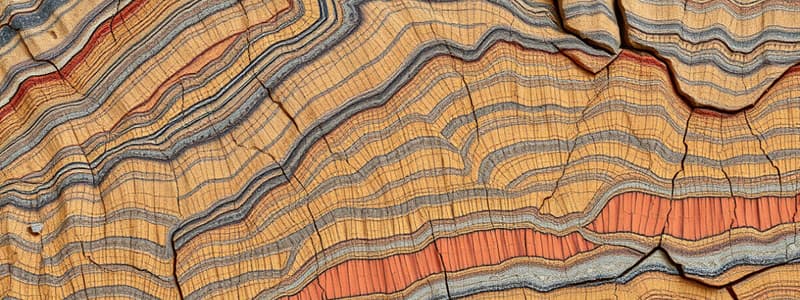Podcast
Questions and Answers
What is foliation?
What is foliation?
- Layering of igneous rocks.
- Alignment of any kind observed in any kind of rocks.
- An alignment of mineral grains in a metamorphic rock. (correct)
- Layering observed in sedimentary rocks.
Foliated metamorphic rocks are never:
Foliated metamorphic rocks are never:
- Low grade.
- High-grade.
- Foliated.
- Caused by contact with magma. (correct)
Shearing is a type of:
Shearing is a type of:
- Compressive stress.
- Differential stress. (correct)
- Lithostatic pressure.
- Confining pressure.
Metamorphic rocks with a planar texture (minerals are aligned within the rock) are:
Metamorphic rocks with a planar texture (minerals are aligned within the rock) are:
Metamorphic rocks are classified primarily according to:
Metamorphic rocks are classified primarily according to:
Which of the following is a non-foliated metamorphic rock?
Which of the following is a non-foliated metamorphic rock?
The major difference between metamorphism and metasomatism is:
The major difference between metamorphism and metasomatism is:
Ore bodies at divergent plate margins can be formed by:
Ore bodies at divergent plate margins can be formed by:
Metamorphic rocks with the same mineral assemblage belong to the same:
Metamorphic rocks with the same mineral assemblage belong to the same:
A metamorphic rock that has undergone partial melting to produce a hybrid metamorphic-igneous rock is called:
A metamorphic rock that has undergone partial melting to produce a hybrid metamorphic-igneous rock is called:
Which of the following lists is arranged in order from highest to lowest grade of metamorphic rock?
Which of the following lists is arranged in order from highest to lowest grade of metamorphic rock?
The generally accepted temperature limits for metamorphism are:
The generally accepted temperature limits for metamorphism are:
The principal agents of metamorphism are:
The principal agents of metamorphism are:
When rocks are metamorphosed, the mineral components of the rock are:
When rocks are metamorphosed, the mineral components of the rock are:
Contact metamorphism results whenever:
Contact metamorphism results whenever:
Regional metamorphism:
Regional metamorphism:
Slate is a metamorphic rock type associated with:
Slate is a metamorphic rock type associated with:
Gneiss is a metamorphic rock associated with:
Gneiss is a metamorphic rock associated with:
Metamorphism of limestone may contribute to global warming by the release of:
Metamorphism of limestone may contribute to global warming by the release of:
Flashcards are hidden until you start studying
Study Notes
Foliation and Metamorphism
- Foliation: Alignment of mineral grains in metamorphic rocks, resulting in a layered appearance.
- Foliated Metamorphic Rocks: Not caused by contact with magma; typically formed under directed pressure.
- Shearing: A form of differential stress that distorts rock shapes.
Classification of Metamorphic Rocks
- Metamorphic rocks are categorized based on texture, particularly the presence or absence of foliation.
- Non-foliated metamorphic rock example: Quartzite, which lacks a layered structure.
- Metamorphic Facies: Groups of metamorphic rocks that share the same mineral assemblage, indicating similar metamorphic conditions.
Processes Involved in Metamorphism
- Metasomatism: A process that involves the introduction of additional ions, distinguishing it from regular metamorphism.
- Hydrothermal Processes: Can form ore bodies at divergent plate margins, involving mineralization from hot, mineral-rich water.
- Contact Metamorphism: Occurs when magma contacts surrounding rocks, leading to changes due to heat.
Conditions and Agents of Metamorphism
- Metamorphism typically occurs between 200 degrees Celsius and the onset of rock melting.
- Principal agents of metamorphism include heat and pressure, which facilitate mineral transformation.
- When rocks metamorphose, their mineral components are transformed in a solid state without melting.
Types of Metamorphic Rocks and Grades
- Grade of Metamorphic Rocks: The sequence from highest to lowest grade is gneiss, schist, phyllite, slate.
- Slate: Associated with low pressure and low temperature conditions, making it less metamorphosed.
- Gneiss: Formed under high temperature and high pressure conditions, indicative of significant metamorphic processes.
Impact on Climate
- The metamorphism of limestone can release carbon dioxide, potentially contributing to global warming.
Summary of Regional and Contact Metamorphism
- Regional Metamorphism: Produces foliated rocks over extensive areas under high temperature and pressure.
- Contact Metamorphism: Results specifically from magma interaction with surrounding rocks.
Studying That Suits You
Use AI to generate personalized quizzes and flashcards to suit your learning preferences.



